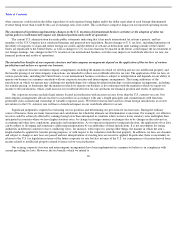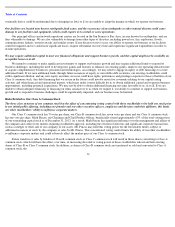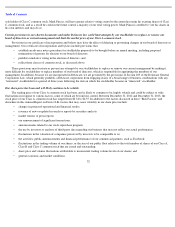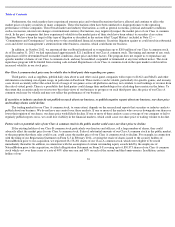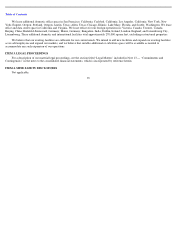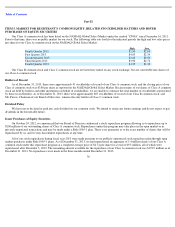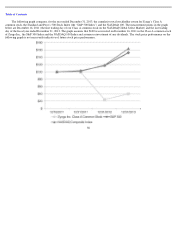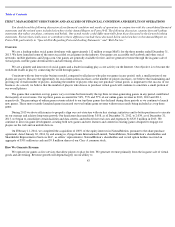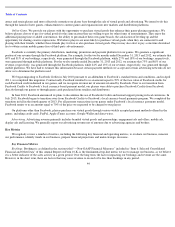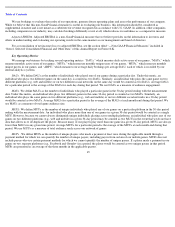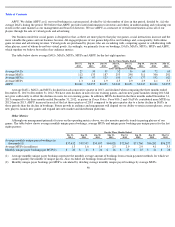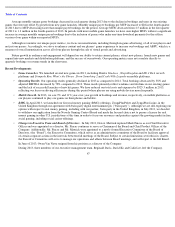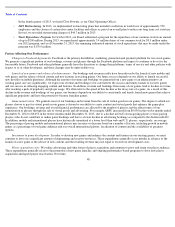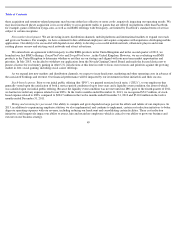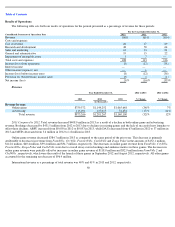Zynga 2013 Annual Report Download - page 44
Download and view the complete annual report
Please find page 44 of the 2013 Zynga annual report below. You can navigate through the pages in the report by either clicking on the pages listed below, or by using the keyword search tool below to find specific information within the annual report.
Table of Contents
Stock-based expense included in the statements of operations data above was as follows:
Non-GAAP Financial Measures
Bookings
To provide investors with additional information about our financial results, we disclose within this Annual Report on Form 10-K,
bookings, a non-GAAP financial measure. We have provided below a reconciliation between bookings and revenue, the most directly
comparable GAAP financial measure.
Bookings is a non-GAAP financial measure that is equal to revenue recognized during the period plus the change in deferred revenue
during the period. We record the sale of virtual goods and mobile downloads as
40
(1) See the section titled “Non-GAAP Financial Measures” below for how we define and calculate bookings, a reconciliation between bookings
and revenue, the most directly comparable GAAP financial measure and a discussion about the limitations of bookings and adjusted
EBITDA.
(2) See the section titled “Non-GAAP Financial Measures” below for how we define and calculate adjusted EBITDA, a reconciliation between
adjusted EBITDA and net income (loss), the most directly comparable GAAP financial measure and a discussion about the limitations of
bookings and adjusted EBITDA.
(3) DAUs is the number of individuals who played one of our games during a particular day, as recorded by our internal analytics systems.
Average DAUs is the average of the DAUs for each day during the period reported. See the section titled “Management’s Discussion and
Analysis of Financial Condition and Results of Operations—Key Metrics—Key Operating Metrics—DAUs” for more information on how
we define and calculate DAUs. This reflects 2009 data commencing on July 1, 2009.
(4) MAUs is the number of individuals who played a particular game during a 30-day-period, as recorded by our internal analytics systems.
Average MAUs is the average of the MAUs at each month-end during the period reported. See the section titled “Management’s Discussion
and Analysis of Financial Condition and Results of Operations—Key Metrics—Key Operating Metrics—MAUs” for more information on
how we define and calculate MAUs. This reflects 2009 data commencing on July 1, 2009.
(5) MUUs is the number of unique individuals who played any of our games on a particular platform during a 30-
day period, as recorded by our
internal analytics systems. Average MUUs is the average of the MUUs at each month-end during the period reported. See the section titled
“Management’s Discussion and Analysis of Financial Condition and Results of Operations—Key Metrics—Key Operating Metrics—
MUUs
”
for more information on how we define and calculate MUUs. This reflects 2009 data commencing on July 1, 2009.
(6) ABPU is defined as (i) our total bookings in a given period, divided by (ii) the number of days in that period, divided by (iii) the average
DAUs during the period. See the section titled “Management’s Discussion and Analysis of Financial Condition and Results of Operations—
Key Metrics—Key Operating Metrics—ABPU” for more information on how we define and calculate ABPU. This reflects 2009 data
commencing on July 1, 2009.
Year Ended December 31,
2013
2012
2011
2010
2009
Cost of revenue
$
468
$
12,116
$
17,660
$
2,128
$
443
Research and development
61,931
200,640
374,920
10,242
1,817
Sales and marketing
8,079
24,684
81,326
7,899
518
General and administrative
13,915
44,546
126,306
5,425
1,212
Total stock
-
based compensation
$
84,393
$
281,986
$
600,212
$
25,694
$
3,990
Year Ended December 31,
2013
2012
2011
2010
2009
Consolidated Balance Sheet Data:
Cash, cash equivalents and marketable securities
$
1,541,970
$
1,652,313
$
1,917,606
$
738,090
$
199,958
Property and equipment, net
348,793
466,074
246,740
74,959
34,827
Working capital
964,897
975,225
1,355,224
385,564
(12,496
)
Total assets
2,279,085
2,576,320
2,516,646
1,112,572
258,848
Deferred revenue
189,915
347,005
480,645
465,236
223,799
Total stockholders
’
equity (deficit)
1,877,271
1,825,503
1,749,539
482,215
(21,478
)


